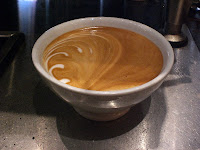Canned coffee is ubiquitous in Japan, with a large number of companies competing fiercely and offering various types for sale. Japanese canned coffee is already brewed and ready to drink. It is available in supermarkets and convenience stores, with vast numbers of cans being sold in vending machines that offer heated cans in the autumn and winter, and cold cans in the warm months.
Canned coffee is a Japanese creation, and the term kan kōhī is wasei-eigo: the English-language term "can coffee" was created in Japan and is believed to have entered English usage as a way of distinguishing it from a typical can of, for instance, Folgers or Nescafé. In the United States, at least, "canned coffee" is the preferred term, if used at all.
UCC Ueshima Coffee Co. is well known in Japan for pioneering canned coffee with milk in 1969. The official government web site of Shimane Prefecture, Japan, claims that the world's first canned coffee—Mira Coffee—appeared in Shimane in 1965, but this was short-lived.
More significant perhaps was the 1973 introduction by Pokka Coffee of the hot and cold drink vending machine. The Japanese Wikipedia version of this article claims that it was this introduction that allowed the industry to take off, and in 1983 canned coffee makers shipped more than 100 million cases.
One noteworthy element of Japanese canned coffee is the liberal use of English both for the word "coffee" and the brand name. English is also used. Occasionally the Japanese word kōhī (コーヒー?) dominates the can design, or, for effect, the kanji for coffee (珈琲?) may be used as well (also pronounced kōhī). Apart from company and content information English is the primary language used on Japanese coffee cans, often for marketing and branding reasons.
Can design and shape have changed drastically. The earliest cans were simple in terms of graphic design and were often corrugated in the middle two-thirds of the can. Cans with straight steel sides appeared next, finally settling on a more modern shape. Like the earlier cans, this type also starts as a flat sheet that is curled and seamed. Extruded steel is also used extensively. Aluminum coffee cans are almost non-existent, although UCC Black is a notable exception.
Certain clichés entered the world of canned coffee graphic design early on and remain in use today. One in particular is white cream swirling into a cup of black coffee, while another is coffee beans. A more noteworthy cliché is the use of Western faces as part of the design, notably Pokka Original from the early 1970s, and Boss Coffee which first appeared in the early 1990s. Of seemingly more recent origin is the use of ice cubes on many iced coffee brands.
Do want to have a coffee? - [Co fui no mu?]
Some article from: http://en.wikipedia.org/wiki/Canned_coffee
Photos from: http://japanguidebook.com
http://photo-dict.faqs.org/photofiles/list/1441/1955Japan%27s_flag.jpg






